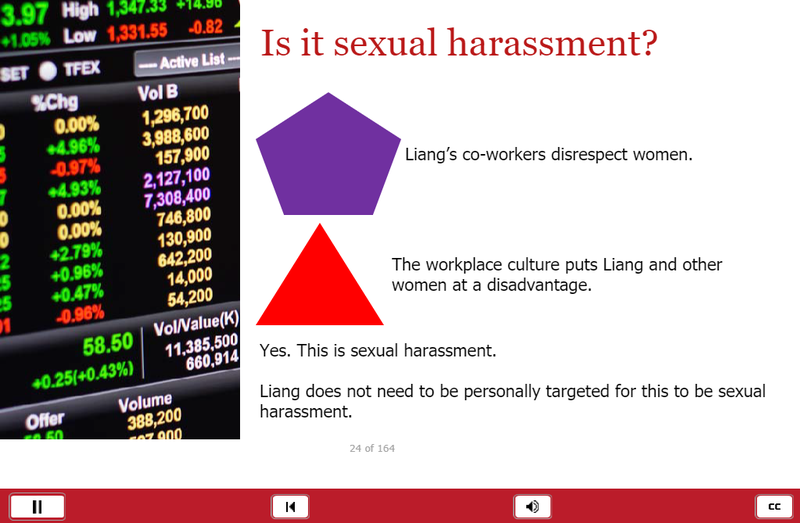The #MeToo movement is a bitter reminder of the destructive power of sexual harassment in business. Sexual harassment is hard to deflect, hard to report, and hard to address once the damage is done.
That’s why it’s so important to push back hard in your workplace with a zero-tolerance sexual harassment policy and timely training. This is especially important because the line between acceptable conduct and sexual harassment often isn’t as obvious as you might think.
Unwelcome sexual advances, requests for sexual favors, and treating someone better or worse because of sexual attraction are all examples of sexual harassment. But they’re just the most blatant.
Sexual harassment also encompasses comments that disrespect or sideline coworkers based on their gender. It’s easy for this kind of harassment to fly under the radar, subtly eroding your corporate culture. By the time someone complains, the damage is done.
Gendered disrespect includes jokes and subtle put-downs based on gender stereotypes. For example, a woman with children might be teased about “mommy brain,” or a man might be teased about his quilting hobby.
Studies have shown that people tease as a way to build closer relationships and establish an insider culture, but the problem is that jokes can reinforce stereotypes. They can even invite more overt forms of sex-based discrimination and harassment. And if they happen often enough to make an employee feel sidelined, disparaged, or discouraged, they can meet the legal bar for sexual harassment.
Overview: What is classified as sexual harassment?
Sexual harassment is a form of sex discrimination that violates Title VII of the Civil Rights Act of 1964 (Title VII). It includes any unwelcome conduct related to sex or gender that negatively affects someone’s work.
The Equal Employment Opportunity Commission (EEOC) recognizes two basic types of sexual harassment. “Quid pro quo” harassment is coercion. For example, a manager might pressure an employee to accept sexual advances with a promise of a promotion or a threat of firing.
“Hostile environment” harassment is when unwelcome sexual conduct happens persistently enough to interfere with someone’s work. An example is coworkers who frequently talk about their sex lives at work, making others uncomfortable.
The EEOC notes that sexual harassment doesn’t include “simple teasing, offhand remarks, or isolated incidents that are not very serious.” Teasing must be serious or pervasive enough to interfere with someone’s work to meet the bar.
Preventing sexual harassment is a legal duty for employers as well as a human resources (HR) best practice.
As you think about addressing sexual harassment in your workplace, keep in mind:
• It’s not only sexual: It can also be more general comments about gender.
• It affects men and women: More than 16% of sexual harassment charges filed with the EEOC in 2019 were brought by men.
• It’s not just bosses behaving badly: Harassment can come from a boss, a coworker, or even a contractor or vendor who visits your workplace infrequently.
• It can affect people who aren’t being harassed: Coworkers who trade off-color jokes with each other can offend employees who overhear.
• It can invite more overt harassment: If you have a culture where “it’s all in good fun,” who draws the line where the fun stops?
• It can damage employee morale: Harassment can take a heavy, silent toll on your employees and their career ambitions.
• It can be tolerated, until it isn’t: Victims of harassment may tolerate the behavior and even tease back at first as a way of defusing their discomfort.
You can have a workplace free of sexual harassment and other forms of discrimination without walking on eggshells all the time. In fact, setting clear boundaries creates an environment where every employee can feel comfortable and confident.
It all starts with a written sexual harassment policy included in your employee handbook and backed by effective training. Here’s what you need to include to protect your employees and your company from sexual harassment.

What your workplace sexual harassment policy should cover
Your sexual harassment policy should cover these areas:
Commit to a harassment-free workplace
Start positive with a statement about your commitment to a workplace where everyone feels empowered and happy. Align that objective with your company’s mission and values to create your own statement of intent for a welcoming workplace for all employees.
Define sexual harassment
Your policy needs to clearly spell out what sexual harassment is and state that your company has zero tolerance for it. Be specific and provide examples so everyone understands what behaviors are off-limits, including:
• Overt sexual harassment: Unwanted sexual advances, touching, sexual comments, treating someone differently because of a sexual attraction, or requests for sexual favors must be dealt with swiftly. Some complaints, such as sexual assault allegations, may require the involvement of law enforcement.
• Offensive content: Displaying or discussing sexual images or content anywhere at work or having sexual materials on company-owned computers and media should also be strictly prohibited.
• Gender sidelining and disrespect: Jokes that slight someone based on gender stereotypes are harder to monitor. Some instances might require training or conflict resolution, while others might be serious enough to require stronger measures.
• Office relationships: Relationships between supervisors and subordinates can lead to conflicts or charges of sexual harassment. You may address this by prohibiting the relationships, requiring disclosure to HR, or asking the parties to sign a dating contract.
Create reporting procedures
Your policy should make employees feel empowered and encouraged to report harassment. Be sure to cover:
• The duty to report harassment: Require employees to report sexual misconduct, whether it’s directed at them or merely witnessed. Provide detailed instructions for when and how to report sexual harassment.
• Multiple avenues for reporting: Encourage employees to bring complaints or questions to their supervisor, HR, or any member of the leadership team they feel comfortable talking to. Require leaders to promptly report to HR to ensure proper resolution.
• Confidentiality: Reassure employees their complaints will be handled confidentially.
Prescribe discipline
Your policy should lay out what sexual harassment penalties may result from various offenses. Some actions might merit immediate dismissal, while others might call for counseling, training, verbal warnings, written warnings, suspension, or probation.
Prohibit retaliation
Your policy also needs to prohibit retaliation, which is any adverse action taken against employees who complain about sexual harassment. This could be anything from treating an employee differently to giving them less desirable hours or even firing them. Employees need to know that they won’t be punished if they report sexual harassment.
Acknowledge legal rights
Your policy should also acknowledge employees’ rights under state and federal anti-discrimination laws, including Title VII, which prohibits discrimination or harassment based on sex or gender and retaliation for filing complaints.

An example sexual harassment policy
Here’s an example of a sexual harassment policy you can adapt for your workplace.
[Your company] wants all employees to feel respected and empowered at work. To ensure a positive environment for all employees, in accordance with Title VII of the Civil Rights Act of 1964 (“Title VII”), [Your company] prohibits sexual harassment and retaliation in all its forms. Any incidents of sexual harassment by any employee of our company will be taken seriously, investigated thoroughly and fairly, and responded to with appropriate discipline up to and including termination of employment.Sexual harassment
Sexual harassment is any sexual behavior at work that makes someone feel intimidated, coerced, humiliated, or disrespected. All of the following are examples of prohibited sexual harassment:
• Sexual advances: Sexual advances including unwanted touching, assault, offers or requests for sexual favors, sexual comments, treating employees differently because of sexual attraction, and standing too close or brushing up against employees in a sexual manner are strictly prohibited. This includes unwelcome sexual behavior such as leering, whistling, or making obscene noises or gestures. All of these forms of sexual harassment will result in appropriate discipline up to and including immediate termination of employment.
• Verbal harassment: Sexual jokes, comments, or slurs are a form of harassment and have no place in our work environment. This can include comments or questions about someone’s appearance, attractiveness, relationships, or other private matters.
• Comments on gender or orientation: Sexual harassment may also include demeaning remarks or jokes based on gender or gender stereotypes, sexual orientation, or sexual identity. Whether directed at a coworker or merely overheard, verbal harassment is strictly prohibited in [Your company].
• Offensive content: Storing, distributing, displaying, or discussing sexually explicit or suggestive images or content in the workplace or on company-owned property is strictly prohibited. This includes printed or electronic materials that disrespect or ridicule others based on gender, sexual orientation, or sexual identity.
[Your company] understands that anyone can be a victim of sexual harassment, regardless of gender, and anyone who interacts with our employees can be a perpetrator, including contractors, suppliers, and customers. Sexual harassment can happen anywhere our employees work, including at conventions and other off-site events. Any sexual conduct that is unwelcome and makes an employee feel uncomfortable, wherever it occurs, is prohibited sexual harassment.Workplace relationships
Consensual romantic relationships between managers or supervisors and their subordinates are discouraged because they can create conflicts of interest or the appearance of conflicts. This can damage team dynamics.
If any manager or supervisor enters a relationship with a subordinate employee, both parties must immediately report the relationship to the HR director. HR will pursue potential remedies such as reassignment.
Retaliation
At [Your company], employees can report sexual harassment without fear of punishment. Retaliating against an employee who complains or inquires about sexual harassment is illegal and strictly prohibited by [Your company]. This includes any adverse treatment following a complaint, such as ignoring or slighting the employee, providing less favorable hours or other working conditions, withholding privileges or information, denying promotions or development opportunities, or demoting or firing the employee.
Managers or supervisors who retaliate against an employee for reporting sexual harassment will be subject to discipline up to and including termination.
Duty to report
If you believe you are a victim of sexual harassment, or if you witness any instances of sexual harassment at [Your company], you must report the incident promptly to your supervisor or our HR director, [Name]. If you are uncomfortable reporting the harassment to either of those parties, you should report it to a member of the leadership team you feel comfortable with.
If you are unsure whether conduct rises to the level of harassment, you should report it.
HR will work confidentially with the relevant parties and with [Your company’s] legal advisor to investigate the incident and respond appropriately. All investigations will be documented and reviewed by senior management to ensure proper, impartial application of this policy.
The identity of employees who report sexual harassment will be kept confidential except as required to investigate and respond to the complaint. HR will discuss any necessary disclosures with the employee before sharing information with others.
Disciplinary actions
Sexual harassment is subject to discipline including counseling, training, verbal warning, written warning, reassignment, demotion, suspension, probation, and termination. The severity of the conduct will determine the appropriate discipline.
The HR director, senior management, and our legal counsel will review all complaints, assign discipline, and document the results. These documents will be maintained in secure files.
Right to complain
Nothing in this policy replaces or interferes with your right to file sexual harassment or discrimination complaints with the Equal Employment Opportunity Commission (EEOC) or other regulatory agencies.
Policies inform, training transforms
To help employees identify and prevent harassment, you need to back up your policy with sexual harassment training during onboarding and annually thereafter. HR software can make it easy to manage sexual harassment forms and policies and track employee training. You can also administer sexual harassment training through a learning management system.
Include concrete examples of different types of harassment and how employees should respond. Let employees work through scenarios illustrating the various forms sexual harassment can take.
Many states and cities have sexual harassment laws and requirements that go beyond Title VII. Some require employers to provide sexual harassment prevention training. Often, states and cities will offer free online training to help employers comply.
Active training exercises drive home your message, bring the subject of sexual harassment into the open, and encourage the view that it is a problem employees and teams can address.
Create a safe, positive work environment
Sexual harassment can silently, profoundly damage an employee, a team, a department, and your entire company. A strong sexual harassment policy, backed by all-employee training, sets clear expectations for behavior. It also gives your employees the tools they need to confront sexual harassment head-on before it can damage their careers — and your company.
The post Why Your Business Needs a Sexual Harassment Policy appeared first on The blueprint and is written by Elizabeth Gonzalez
Original source: The blueprint




